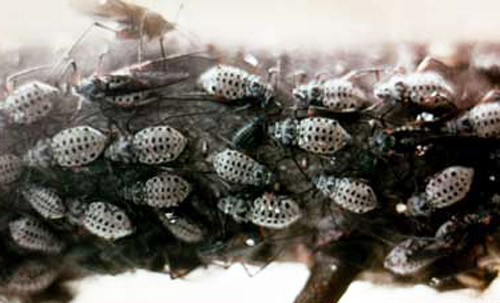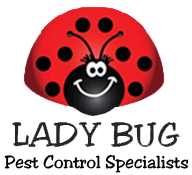This giant Bark Aphid (for an aphid at least) reaches an incredible 6 mm long body and hind legs up to 9 mm in length. That makes the body alone about a quarter of an inch in length, which is enormous for an aphid. It was first found on hickory trees in Massachusetts, but is now known to occur throughout the United States, and likely into southern Canada. It infests a variety of hardwood trees, including oaks, sycamore, elm, willow, basswood, walnut, and pecan, feeding on the bark of the limbs. Whether or not they actually have the potential to kill a tree is not well understood, but very definitely their feeding can weaken individual branches to the point it kills that entire branch.
These may be very noticeable aphids, due to the huge size, long legs, and large numbers found in masses on the trunks and branches. They are dark gray in color, with 4 rows of black spots running parallel along the upper side of the thorax and abdomen. Their life cycle is typical of aphids, with the eggs deposited in crevices on the host trees in the fall, the eggs over-wintering, and the new aphids emerging in the spring. They often

remain on the same plant for many generations, and are visible and active throughout the summer months. Because of this habit of staying put the bark aphids may be most numerous and noticeable in late summer. They may also wander or fall off the tree and end up on patios and decks, where they leave orange stains if crushed, and otherwise become an odd and unwanted nuisance.
Control could begin in the winter on trees known to have been infested the previous season. It is during this leafless part of the year that dormant oils can be applied to the trunks and larger branches, coating the eggs that have been placed there and smothering them by closing them off from needed oxygen. Generally speaking the use of oil based insecticides is considered a “green” approach to pest management on ornamental plants. Oils kill by a mechanical action rather than a toxic effect, and are specific to the insects and their early stages that are contacted during the application. This also offers your customers a very worthwhile and legitimate service that can be done during the winter months, when pest control often is considered to be at its lowest need.
In general there are two approaches to this – soil applications of systemic insecticides and direct treatment of the foliage or branches that are infested. The fastest way to eliminate an aphid population is to spray it directly, instantly killing the aphids that are exposed, and a great many products are labeled for this use. For many aphid problems it is even effective to simply spray the insects with a strong stream of water, washing them physically off the plant. For many aphids that are foliar pests this will cause their death, as they are unable to wander back onto the plant. For bark aphids, which are strong walkers, this may be only a temporary respite, and killing them could be needed.
If you have concerns and want a Free Home Inspection contact Lady Bug Pest Control Specialists for a Free Home Inspection for Termites, Eco-Friendly Pest Control, Home Seal Service, Bed Bug Eco-Heat, and Rodent Control. We perform Complete Home Inspections at no charge. Please feel free to contact Lady Bug Pest Control Specialists to answer any questions or for a FREE Inspection. 480-833-1111.
Lady Bug Locations: Lady Bug Eco-Friendly Pest Control provides service Valley Wide including Mesa, Tempe, Scottsdale, Paradise Valley, Phoenix, Cave Creek, Care Free, Fountain Hills, Gilbert, Chandler, Queen Creek, San Tan, Sun City, Peoria, Buckeye, Avondale, Good Year, Glendale, Surprise, Apache Junction, Gold Canyon, Anthem, Ahwatukee, and El Mirage







